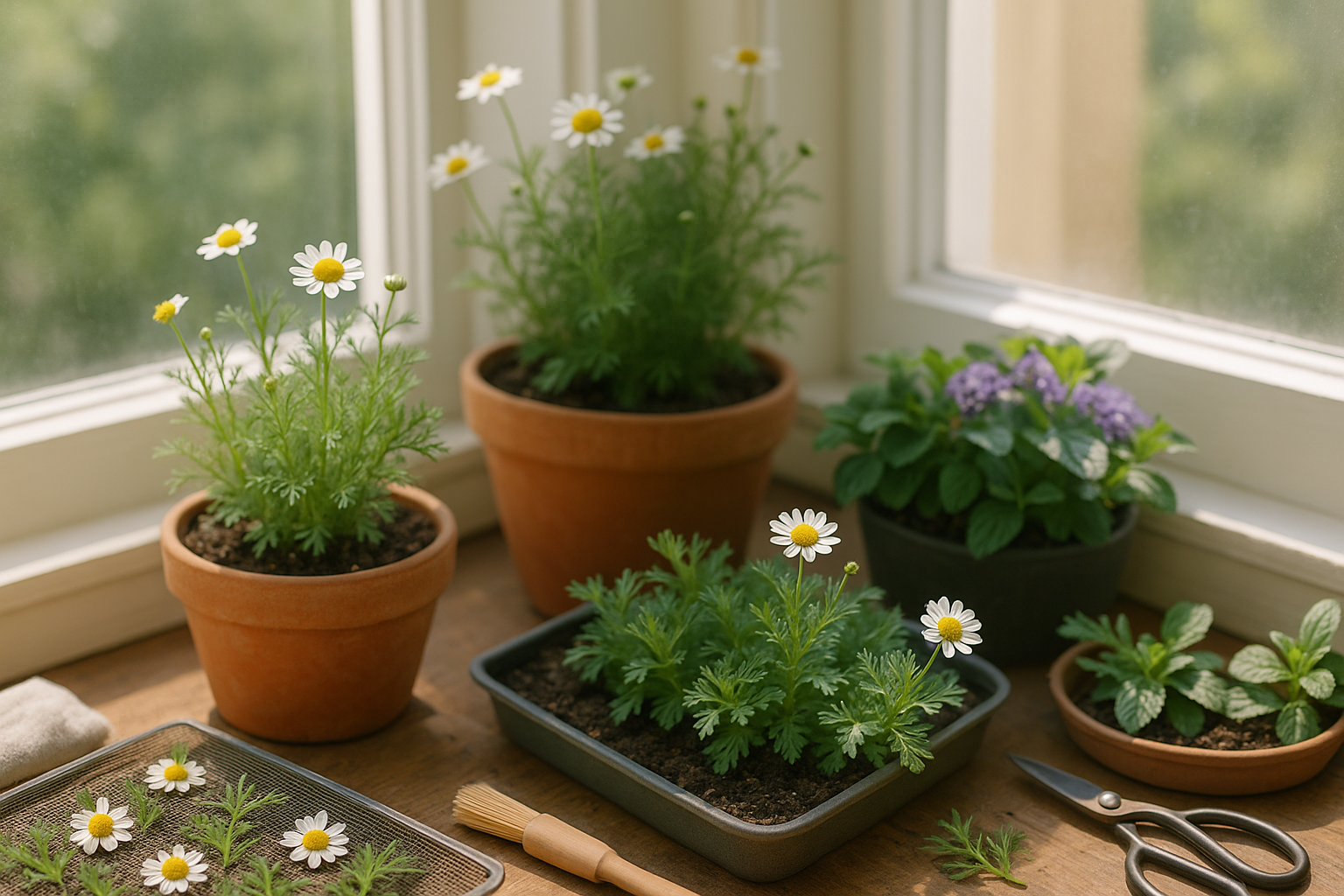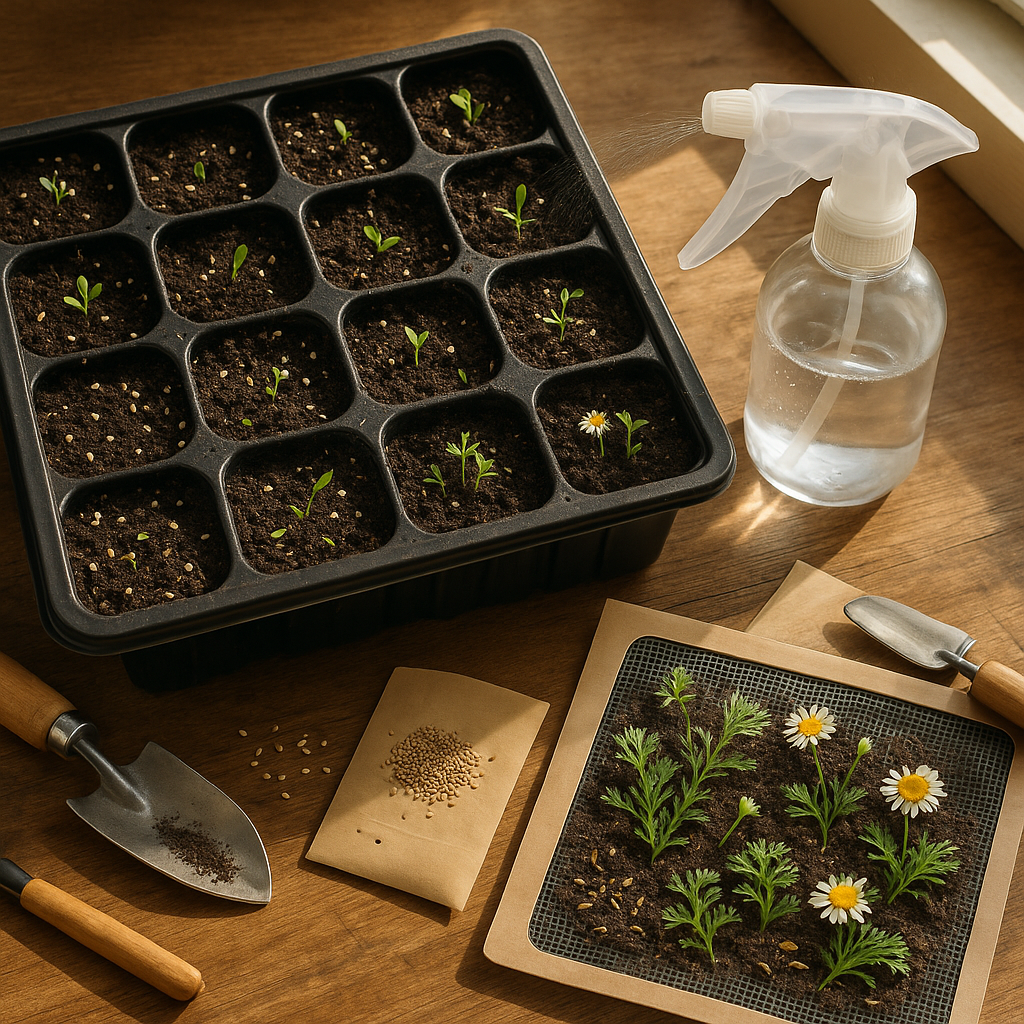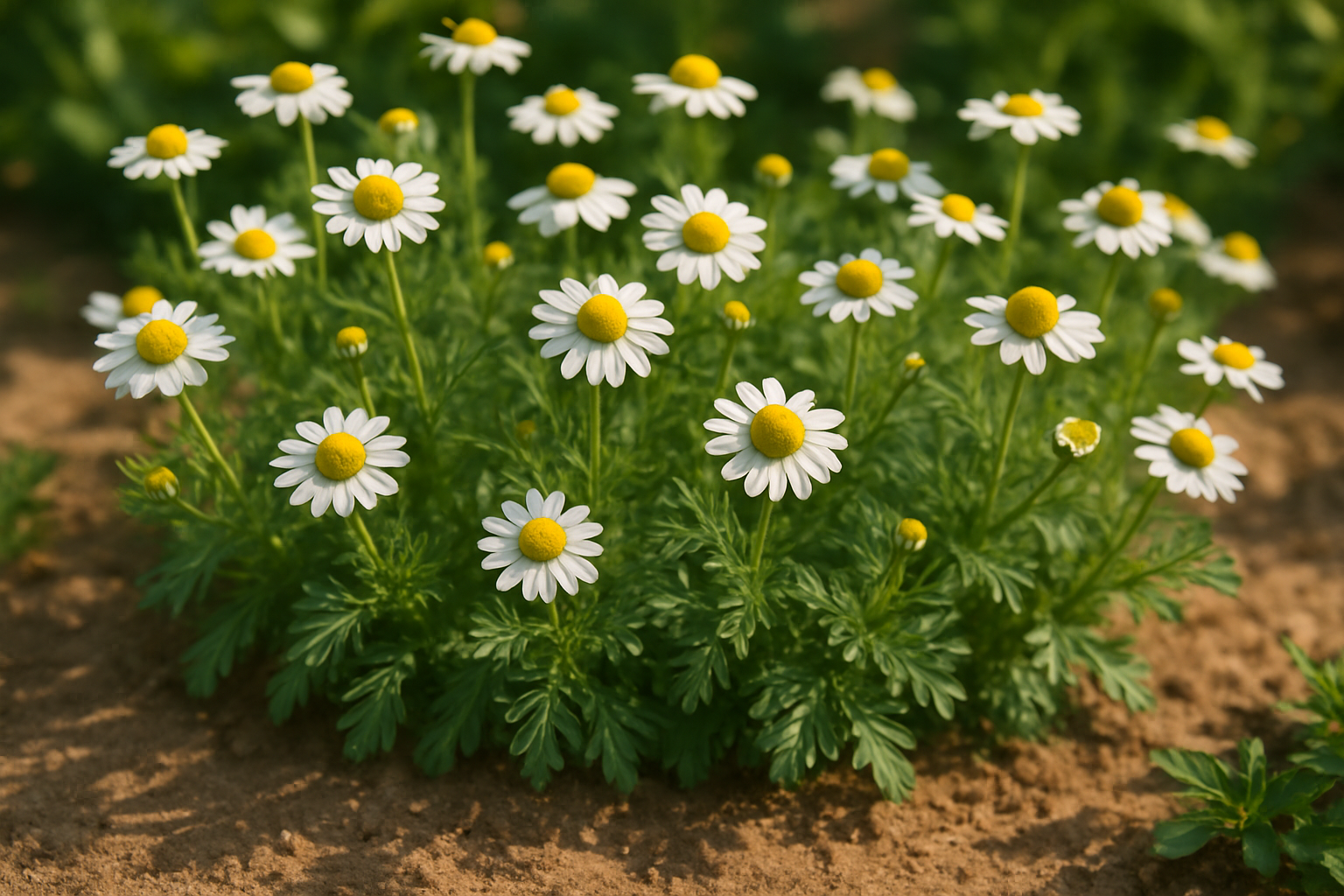Can You Grow Chamomile Year-Round?

Growing chamomile year-round is possible, but it’s important to understand its preference for cool conditions and plenty of sunlight. Using indoor pots or greenhouses can help maintain the ideal environment throughout every season.
Understanding Chamomile Basics
Chamomile is a gentle, aromatic herb treasured in both gardens and kitchens for its soothing qualities and charming daisy-like flowers. There are two main types: German chamomile (Matricaria chamomilla) and Roman chamomile (Chamaemelum nobile).
German chamomile is an annual, completing its lifecycle in one season and often self-seeding to return year after year. Roman chamomile, in contrast, is a perennial that comes back each spring from the same roots, forming a low, mat-like ground cover.
Both types are loved for their delicate, apple-scented blossoms, but they do have subtle differences: German chamomile tends to grow taller with feathery foliage, while Roman chamomile stays shorter and spreads more across the soil.
Chamomile’s basic properties include anti-inflammatory and calming effects, which make it a staple in herbal teas, natural sleep aids, and soothing skin treatments like salves or compresses. It’s also used in homemade hair rinses to add shine and lighten hair naturally.
For gardeners, chamomile is a reliable companion plant that attracts pollinators and beneficial insects, helps repel pests, and thrives with minimal care. It prefers sunshine, well-drained soil, and can tolerate some drought.
Its gentle nature and versatility make chamomile easy to grow for beginners and rewarding for seasoned gardeners alike. With its sweet fragrance, resilience, and wide range of uses—from calming tea to natural remedies—chamomile truly earns its place as a garden favorite. It fits effortlessly into herb beds, borders, or even patio pots.
Many appreciate how a small patch of chamomile not only adds beauty but also brings a sense of tranquility and purpose to any garden space.
Chamomile’s Ideal Growing Conditions
Chamomile flourishes best in mild climates with temperatures ranging between 60°F and 68°F (15°C–20°C), making it an excellent choice for spring and early summer gardens. It prefers full sunlight but will tolerate partial shade, especially in hotter regions where midday sun can be too intense.
When it comes to soil, chamomile isn’t picky but thrives in well-drained, moderately fertile ground with a slightly acidic to neutral pH, typically between 5.6 and 7.5. Heavy, soggy soils can cause root rot, so mixing in sand or compost improves drainage and supports healthy root development.
Outdoors, chamomile is happy in garden beds or pots, but you’ll want to plant after the danger of frost has passed and the ground begins warming. Indoor growers can give chamomile a head start by placing pots in a sunny windowsill or under grow lights, where temperatures are steady and easily controlled.
Indoors, humidity should be moderate—aim for 40–60%—because overly dry air can stunt growth while high humidity encourages fungal problems. In regions with harsh winters or extremely hot summers, outdoor chamomile is often treated as an annual, replanted each year after frost or extreme heat threats subside.
By contrast, indoor conditions rarely fluctuate, allowing chamomile to potentially grow and bloom year-round if it receives enough light and stable warmth. In temperate areas, gardeners sometimes prolong the harvest by succession planting or moving containers indoors as temperatures dip.
No matter where you grow it, paying attention to temperature, sunlight, and soil will maximize your harvest of those fragrant, soothing flowers, so adapt your strategy to your local conditions for the healthiest chamomile plants.
Growing Chamomile Indoors and in Controlled Environments
Growing chamomile indoors or in controlled environments offers many benefits—fresh, homegrown herbs year-round, protection from outdoor pests, and convenient access to soothing blooms right on your windowsill or countertop. Using containers allows you to control soil quality, while grow lights or bright windows help maintain steady growth even during the short, gray days of winter. Although greenhouses can extend the growing season, a sunny corner inside works just fine if you choose the right spot.
The main challenges for indoor chamomile are ensuring enough light—aim for at least 6 hours of direct sun or supplement with a full-spectrum LED grow light positioned 6-12 inches above the plants—and maintaining temperatures between 65-75°F. Cool drafts or sudden heat from radiators can stress these tender herbs, so try to provide a steady, moderate climate.
For potting, use a well-draining container at least 6-8 inches deep and fill it with a light, sandy mix; chamomile dislikes soggy roots, so make sure pots have drainage holes and empty saucers after watering. Water only when the top inch of soil feels dry, and avoid wetting the leaves to discourage fungal issues.
Watch for indoor-specific problems like:
- Fungus gnats (water less often to let the soil dry)
- Powdery mildew (improve airflow and avoid crowding)
- Leggy stems (increase light exposure)
Fertilize sparingly—too much nitrogen encourages lush leaves but fewer flowers. Rotate containers regularly so each plant gets even light, and pinch back stems if needed to promote bushier, more compact growth. With a bit of attention to light, warmth, and moisture, you’ll have a thriving chamomile patch indoors, ready for fresh teas and relaxing aromas all year long.
Sowing, Planting, and Year-Round Care

Starting with chamomile is simple, whether you’re sowing seeds or transplanting seedlings. Begin by selecting a sunny spot with well-drained, average soil. For seeds, scatter them lightly over moist soil in early spring, pressing them gently without covering—they need light to germinate. Mist the area to keep it slightly damp until sprouts emerge in about 7–14 days. When seedlings are 2 inches tall, thin them so plants are spaced about 8 inches apart.
Alternatively, start seeds indoors 4–6 weeks before your last frost, then transplant sturdy seedlings outdoors when temperatures warm and frost danger passes. To extend your harvest, try sowing seeds or transplanting small batches every 2–3 weeks through midsummer. This staggered approach ensures fresh blooms well into late summer and early fall.
For ongoing care, water young plants regularly until established, then allow soil to dry out between waterings—chamomile dislikes soggy roots. Feed with a balanced, diluted fertilizer once a month, but avoid over-fertilizing, which can produce lush leaves at the expense of flowers. Prune spent blooms weekly to encourage continuous flowering, and cut chamomile back by half after its first flush to coax a second round of growth.
Watch for common issues:
- If leaves yellow, reduce watering to avoid root rot.
- If aphids appear, spray with a gentle solution of water and dish soap.
- Powdery mildew can be minimized by providing good airflow and not crowding plants.
With these steps and a little attention throughout the year, you’ll have a virtually carefree chamomile patch that rewards you with flowers for tea, crafts, and the joy of a thriving garden.
Overwintering and Seasonal Challenges
Overwintering chamomile outdoors requires some planning, especially if you live in a region with harsh winters. Start by adding a thick layer of organic mulch, such as straw or shredded leaves, around the base of your chamomile plants after the first frost but before the ground freezes. This insulating blanket helps moderate soil temperature and moisture, protecting delicate roots from freeze-thaw cycles.
If temperatures regularly dip below 20°F (-6°C), consider using frost cloths or row covers. These can be draped over your plants for extra protection on particularly cold nights. In colder climates or if you’re growing chamomile in pots, bring containers indoors or into an unheated garage where they’ll stay sheltered from severe cold yet still receive enough light.
When facing extreme heat, provide partial afternoon shade using garden fabric or plant chamomile in a spot with dappled sunlight. Keep the soil consistently moist but not soggy to help plants withstand heatwaves. Mulch can also help retain moisture during dry periods.
Throughout the year, watch for common chamomile pests like aphids and thrips. These can be managed by spraying plants with a strong stream of water, introducing ladybugs, or applying insecticidal soap. Fungal diseases such as powdery mildew and damping-off may appear if plants are overcrowded or grown in persistently moist conditions.
To prevent fungal issues, space chamomile adequately, water early in the day, and ensure good air circulation around your plants. Remove and dispose of any diseased foliage promptly to stop infections from spreading.
By combining these practical strategies—from proper mulching and protective coverings to attentive pest and disease control—you can help your chamomile thrive despite the seasonal ups and downs.
Harvesting, Storage, and Using Chamomile Year-Round
To make the most of your chamomile harvest, timing is everything. The best moment to pick chamomile is in the morning, just after the dew has dried but before the midday sun. At this time, the flower heads are fully open and packed with the most flavor and beneficial oils.
Snip the flowers gently above the stem, taking care not to damage the plant so it continues to produce blooms throughout the season. For drying, spread the flowers in a single layer on a clean screen or paper towel in a warm, well-ventilated area away from direct sunlight—good airflow is key to preserving the delicate oils. You’ll know they’re ready when they feel crisp to the touch, usually after about a week.
Once dried, store the flowers in an airtight container like a glass jar, tucked away in a cool, dark place; this keeps their soothing aroma and medicinal properties intact for months.
Dried chamomile is incredibly versatile:
- Steep a few teaspoons in hot water for a calming herbal tea.
- Mix into a homemade bath soak for relaxation.
- Tuck sachets of dried blossoms into your linen closet for a fresh, floral scent.
- Infuse chamomile into DIY skin salves.
- Blend with honey to boost its gentle, therapeutic qualities.
With these simple steps, your homegrown chamomile will be ready to enjoy all year long, bringing a touch of summer comfort to even the chilliest days.
Frequently Asked Questions About Growing Chamomile All Year
Many people wonder if chamomile can bloom indoors year-round, and the good news is that it’s definitely possible with the right care. Chamomile thrives on as much light as you can provide, so during the winter months, place your pots on the sunniest windowsill—south-facing is best.
If natural light is limited, using a basic LED grow light for 12–14 hours a day can help prevent the plants from becoming leggy. Legginess, or stretched-out stems, usually happens when chamomile isn’t getting enough light; simply trim these stems back and increase the light exposure as a quick fix.
For soil, use a loose, well-draining potting mix and avoid heavy garden soil, which can suffocate the roots. Chamomile doesn’t like overly rich soil or too much fertilizer—a monthly feeding with diluted liquid fertilizer is enough, especially during the growing season.
If blooms are sparse, check that your plants aren’t sitting in soggy soil and aren’t overcrowded. Improve airflow and space out pots if needed. Keep humidity moderate and let the top inch of soil dry out between waterings.
Regularly snip off spent blooms to encourage more flowers. With these tips, you can enjoy fresh chamomile for tea or decor, no matter the season.
